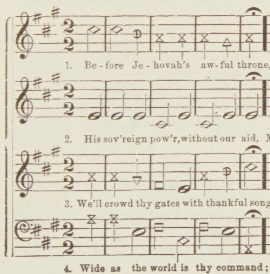



The New Harp of Columbia: A System of Musical Notation, With A Note for Each Sound, And A Shape for Each Note; Containing A Variety of Most Excellent Psalm and Hymn Tunes, Odes, And Anthems, Happily Adapted to Church Service, Singing Schools and Societies was first published in 1867 by Marcus Lafayette Swan (1827-1869). As the name of the book implies, The New Harp of Columbia was preceded by an earlier The Harp of Columbia. The Harp of Columbia was published in 1848 by W. H. and M. L. Swan. There were seven editions of the former book published from 1848 to 1855.
The previous book was a seven-syllable shape-note tune book which was published only two years after Jesse Aikin published the Christian Minstrel, the first seven-syllable shape-note song book. The Swans had to come up with their own design for "Do," "Re," and "Si." Like all other tune book compilers who designed their seven-syllable shape-note systems, they kept the shapes that William Little and William Smith used for "Mi," "Fa," Sol," and "La": a diamond, a right-angle triangle, a circle, and a square. For "Do," the Swans used an hourglass with the stem coming from the middle of the note. For "Re," they used an inverted "C" with the stem going through the middle of the letter; for the quarter note, eighth note, etc., the area between the stem and arch of the "C" was filled in. For "Si," they used a house-top triangle with the stem coming out of the horizontal line; the note-head and stem together look like an arrow. This shape can flip and point downward when positioned in the lower part of the staff.
Scholars have yet to determine the identity of W. H. Swan. There are two possibilities: Marcus's father, William H. Swan, or his cousin, William Harvey Swan. Both had musical abilities and talents. The father was an attorney; the cousin was a farmer and a political appointee. Some scholars lean towards the idea that the father was the W. H. Swan in question because he could afford the financial backing to publish the book, and he died between the last edition of The "Old" Harp in 1855 and the publication of The New Harp in 1867.
In the preface of The New Harp of Columbia, Swan makes the argument that shape-notes are superior to using round notes. He says, "The English alphabet is composed of twenty-six sounds, for each of which there is a distinct character or shape representing it, called a letter. We might, possibly, have learned to read with these all of the same shape, but we could not have learned any more correctly than we have done.
"Music, then, has seven natural sounds, for each of which, in this work, there is a character, or shape, called a note, from which any one can sing much more readily, and as correctly as if they were all the same shape."
He then adds that the four-shape system has "generally, very willingly, and reasonably, given way to this."
Marcus Swan took The "Old" Harp and removed several songs that were seldom used and replaced them with 50-100 songs that were new to this book. Most of the songs that The New Harp kept from the former book saw no changes.
In The "Old" Harp, the authors thought that the key signatures were not needed. All the singer needs to do is to find the "Do" or "La" by reading the shapes to find the key. The songs that were added to The New Harp do show key signatures, but most of the songs that came from the former book saw no changes and still no key signatures.
Reprints of The New Harp of Columbia were published in 1905, 1907, 1909, 1912, 1919, and 1921. The only changes that were made were the color and design of the cover, but not the music itself.
By the 1970s, the book had long been out of print. The University of Tennessee Press was approached with the idea to publish a facsimile edition. They agreed and the facsimile was published in 1978.
In 2001, local singers approached The University of Tennessee Press with the idea of publishing a "restored edition" of The New Harp of Columbia. For the "restored edition," 36 songs that were in The "Old" Harp, and not in The New Harp, were added to the back of book as an appendix. The appendix would also include the Preface, the Introductory Remarks, and the Rudiments from The "Old" Harp. There were no changes made to the main part of the book.
Monthly and annual singings from this book are held in the Knoxville, Tennessee, and surrounding area.
Sources:
Hatchett, Marion J. A Companion to 'The New Harp of Columbia.' (Knoxville: The University of Tennessee Press, 2005).
Swan M. L. and W. H. Swan. The New Harp of Columbia, Restored Edition. Knoxville: The University of Tennessee Press, 2001).